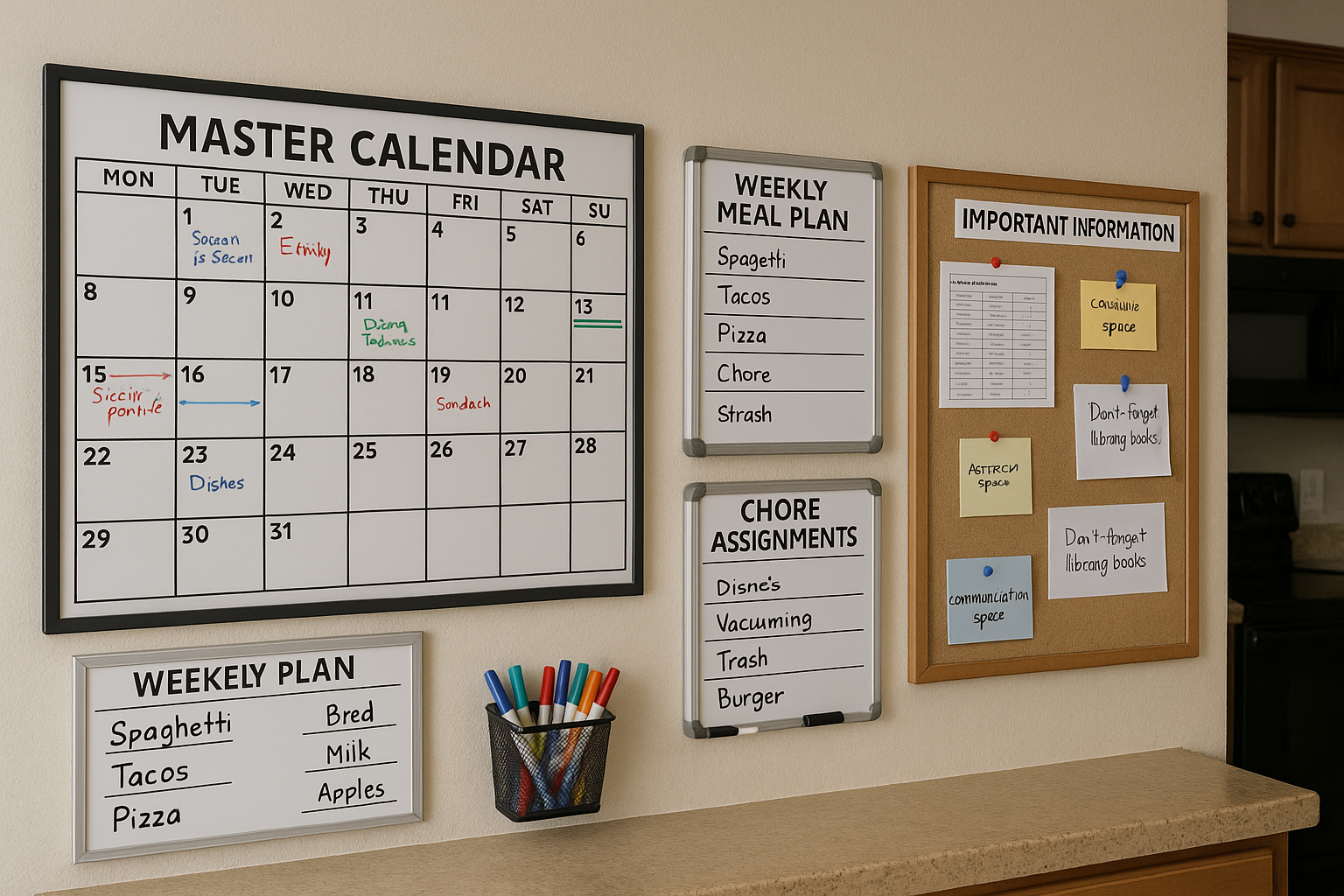Table of Contents
If you’re tired of answering “What’s for dinner?” seventeen times a day, fielding constant questions about schedules, and watching family members wander around confused about whose turn it is to do what, this is for you.
You know that moment when you’re trying to make dinner and three different people ask you three different questions about completely unrelated things? “What time is soccer practice?” “Did you remember to buy groceries for the school project?” “What are we eating tonight?” Meanwhile, you’re standing there with a spatula in one hand wondering why you’ve become the human information desk for everyone else’s lives.
You’ve tried keeping mental lists. You’ve attempted to remember everything important. You’ve even written notes on random pieces of paper that immediately get lost in the daily shuffle. But somehow, crucial information keeps falling through the cracks, and you’re the one who gets blamed when someone misses something important.
Here’s what changed everything for me: I stopped trying to be the family’s walking database and created one central location where everyone could find the information they needed. This family command center isn’t just about organization – it’s about preserving your sanity and giving everyone else ownership of staying informed.
This isn’t about creating a Pinterest-perfect command station with matching containers and cute labels. This is about survival – having one reliable place where important family information lives so you can stop being interrogated every time someone needs to know something.
Why a Family Command Center Is Life-Changing
The genius of a family command center isn’t that it organizes information – it’s that it makes information accessible to everyone instead of just living in your brain. When schedules, meal plans, and responsibilities are visible, family members can answer their own questions instead of constantly asking you.
Traditional family organization relies on one person (usually mom) being the keeper of all knowledge. A family command center distributes that mental load by making everyone responsible for checking and maintaining shared information.
Plus, a family command center actually prevents problems instead of just solving them. When everyone can see what’s planned, they can prepare accordingly. No more last-minute scrambles because someone forgot about early dismissal or the school potluck.
5 Family Command Center Elements That Actually Work
1. The Master Calendar (The Information Hub)
What it includes: Monthly calendar with everyone’s activities, appointments, school events, and important deadlines visible at a glance.
Why it’s essential: This family command center component eliminates 90% of scheduling questions. Instead of asking “When is my dentist appointment?” people can look and find out themselves.
Pro tip: Use different colored markers for each family member so everyone can quickly spot their own commitments without scanning the entire calendar.
2. The Weekly Meal Plan (The Dinner Question Killer)
What it includes: Seven days of planned meals written where everyone can see them. Include prep notes or special instructions if needed.
Why it works: This family command center element single-handedly eliminates the daily “What’s for dinner?” interrogation. People can see what’s planned and even help with prep if they’re motivated.
Bonus: Write grocery needs on the same board so meal planning and shopping list creation happen in one place.
3. The Chore Assignment Board (The Responsibility Tracker)
What it includes: Clear assignments of who does what and when. Rotate weekly or monthly depending on your family’s preferences.
Why it’s genius: This family command center component prevents the “That’s not my job” and “I didn’t know I was supposed to do that” arguments. Everyone can see their responsibilities without negotiations.
Game changer: Include easy ways to mark completion so you can see what’s done without nagging or checking up on people.
4. The Important Information Section (The Daily Details)
What it includes: Emergency contacts, frequently needed phone numbers, school pickup times, activity schedules, and anything else your family asks about regularly.
Why it’s crucial: This family command center area turns you from human information desk back into actual family member. People can find what they need without interrupting whatever you’re doing.
Smart addition: Include wifi passwords, delivery instructions, and other information that visitors or babysitters might need.
5. The Family Communication Space (The Message Center)
What it includes: Space for leaving notes, reminders, or updates for family members. Can be as simple as a section of dry erase board or a small bulletin board.
Why it works: This family command center element creates a reliable way to communicate important information without hoping someone checks their phone or remembers a conversation.
Perfect for: “Need to leave early tomorrow,” “Parent conference notes,” or “Don’t forget library books” type messages that everyone needs to see.
The Psychology Behind Why Family Command Centers Work
There’s something powerful about making information visual and accessible. When people can see what’s expected and planned, they feel more in control and less likely to constantly seek reassurance through questions.
A family command center also creates shared ownership of family management. Instead of one person being responsible for remembering everything, everyone becomes responsible for staying informed and contributing to household organization.
Plus, this system builds independence. Kids learn to check schedules themselves instead of asking. Adults start planning ahead based on visible information instead of making last-minute discoveries about conflicts or commitments.
Setting Up Your Family Command Center for Success
Location is everything: Put your family command center where people naturally gather and pass through multiple times daily. Kitchen is usually ideal because everyone goes there for food and it’s central to most homes.
Keep it simple: Start with basic elements and add complexity only if needed. A dry erase board with sections can work better than an elaborate system with seventeen components.
Make it accessible: Everyone who needs to use the family command center should be able to reach it and update it. Consider heights and abilities of all family members.
Update consistently: The system only works if information stays current. Designate one person to maintain it or create a family routine around updates.
Train the family: Show everyone how to use each component and establish expectations about checking the family command center before asking questions.
Your Family Command Center Starter Kit
Essential Components:
- Large dry erase board – big enough to section into multiple areas
- Different colored markers – one per family member plus black for general info
- Magnetic clips – for holding papers, permission slips, or reminders
- Small basket – for markers, erasers, and other supplies
Upgrade Options:
- Monthly calendar pages – laminated or in clear sleeves for repeated use
- Cork board section – for pinning important papers or photos
- File pocket – for holding forms that need to be returned or papers that need attention
- Small whiteboard – additional space for shopping lists or daily reminders
Organization Tools:
- Labels – to clearly mark different sections if needed
- Magnetic containers – for holding markers and supplies right on the board
- Cleaning supplies – special erasers or cleaners to keep boards looking fresh
- Backup supplies – extra markers because they always dry out at the worst times
Family Command Center Troubleshooting
Problem: Nobody looks at it Solution: Put it somewhere impossible to ignore, and consistently redirect questions to the board instead of answering them directly.
Problem: Information gets outdated Solution: Assign one person to weekly updates, or create a family rule that whoever makes plans writes them on the calendar immediately.
Problem: Too much information, looks overwhelming Solution: Simplify. Keep only essential information visible and store detailed schedules elsewhere.
Problem: Different family members need different information Solution: Use color coding or separate sections so people can quickly find their relevant information without sorting through everything.
Advanced Family Command Center Strategies
The Digital Integration: Take photos of the family command center weekly and text them to family members who are frequently away from home.
The Seasonal Rotation: Adjust the family command center layout based on seasonal needs – more sports schedules in fall, more holiday planning in winter.
The Responsibility Teaching: Use the family command center to gradually transfer planning responsibilities to older kids and teens.
The Guest Information: Include a section with information visitors might need – wifi, house rules, emergency contacts.
The Motivation Addition: Add positive notes, achievements, or family goals to make the family command center about more than just logistics.
When Your Family Command Center Needs Evolution
Growing family: As kids get older and busier, you might need more calendar space or additional organizational components.
Changing routines: New jobs, schools, or activities might require reorganizing how information gets displayed and updated.
Technology integration: Some families eventually move to digital calendars, but often keep the physical family command center for immediate visual reference.
Space constraints: Moving or home changes might require adapting the size or location of your family command center.
The Ripple Effects of a Good Family Command Center
Once this system becomes routine, amazing changes happen beyond just having organized information:
Family independence increases: People stop asking constant questions because they know where to find answers.
Planning becomes collaborative: When everyone can see what’s coming up, they can contribute to solutions and preparation.
Stress levels drop: You stop feeling like the family’s information manager and start feeling like a participant instead of coordinator.
Missed commitments decrease: When schedules are visible, people remember their own responsibilities instead of relying on your reminders.
Morning chaos reduces: When everyone knows what’s planned for the day, morning routines become smoother and more predictable.
The Real Talk About Family Command Centers
This system won’t solve all your family organization problems, and it definitely won’t turn chaotic people into naturally organized ones. What it will do is create a reliable backup system for when memory and verbal communication fail.
The best part about a family command center is that it works with busy family life instead of against it. Instead of requiring everyone to remember everything perfectly, it provides a visual backup that’s always available.
I’ve been using a family command center for years, and it’s completely changed the dynamic in our house. Instead of being the human information desk, I’m just another family member who checks the board when I need to know something.
When Command Centers Become Family Culture
After using this system for a few months, something shifts in your family’s communication patterns. People start automatically checking the board before asking questions. They start adding their own information and updates without being reminded.
The family command center becomes the first stop for information instead of the last resort. Kids start planning their own schedules based on what they see posted. Adults start coordinating with each other through the board instead of playing phone tag.
Eventually, you’ll wonder how your family ever functioned without this central information hub. The relief of not being constantly questioned about schedules and plans is life-changing.
The Bottom Line
A family command center isn’t about being perfectly organized or having a Pinterest-worthy home management system. It’s about creating one reliable place where important family information lives so everyone can stay informed without constantly bothering each other.
When you stop being the family’s walking database and start being a participant in a system that works for everyone, your stress levels drop dramatically. When information is visual and accessible, family members become more independent and responsible for their own awareness.
The next time someone asks you “What’s for dinner?” or “When is my thing?” you can smile and point to the family command center instead of stopping whatever you’re doing to become an information service.
Because life’s too short to spend it answering the same questions repeatedly, and your family is smart enough to read information for themselves if you just give them a place to find it.

